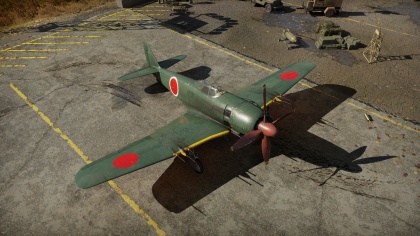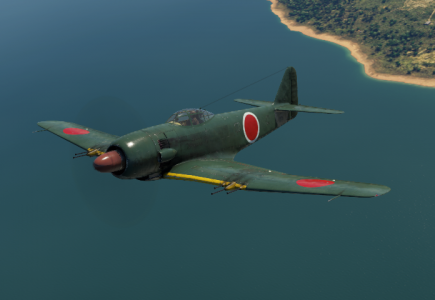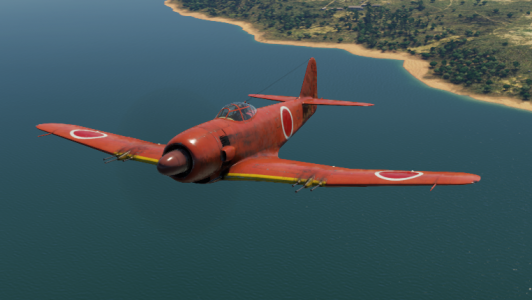J6K1
Contents
Description
The J6K1 is a gift rank IV Japanese fighter
with a battle rating of 6.3 (AB/SB) and 6.7 (RB). It was introduced during Update 1.95 "Northern Wind" as the main pilot reward for the 2019 winter event Operation F.R.O.S.T.
General info
Flight performance
The J6K is an excellent air superiority fighter at its tier that can easily compete with its contemporaries. Originally designed as an interceptor to counter the legendary B-29, it performs the best at altitude and mounts an insane amount of weapons for its size and class at the cost of lower ammunition per gun. Despite the weight of the aircraft, it retains reasonable maneuverability, climb rate and top speed which turn it into an enemy's nightmare when piloted well.
| Characteristics | Max Speed (km/h at 10,000 m) |
Max altitude (meters) |
Turn time (seconds) |
Rate of climb (meters/second) |
Take-off run (meters) | |||
|---|---|---|---|---|---|---|---|---|
| AB | RB | AB | RB | AB | RB | |||
| Stock | 664 | 645 | 13000 | 18.2 | 19.2 | 12.4 | 400 | |
| Upgraded | 710 | 686 | 17.8 | 18 | 20 | 16 | ||
Details
| Features | ||||
|---|---|---|---|---|
| Combat flaps | Take-off flaps | Landing flaps | Air brakes | Arrestor gear |
| ✓ | ✓ | ✓ | X | X |
| Limits | ||||||
|---|---|---|---|---|---|---|
| Wings (km/h) | Gear (km/h) | Flaps (km/h) | Max Static G | |||
| Combat | Take-off | Landing | + | - | ||
| 0 | 320 | 520 | 280 | ___ | ~12 | ~9 |
| Optimal velocities (km/h) | |||
|---|---|---|---|
| Ailerons | Rudder | Elevators | Radiator |
| < 390 | < 390 | < 470 | > 324 |
| Compressor | Optimal altitude | 100% Engine power | WEP Engine power |
|---|---|---|---|
| Setting 1 | 1,000 m | 2,000 hp | 2,190 hp |
| Setting 2 | 4,500 m | 1,785 hp | 1,955 hp |
| Setting 3 | 9,000 m | 1,578 hp | 1,728 hp |
Survivability and armour
- 8 mm steel plate behind the pilot
- Self-sealing fuel tanks (1 underneath pilot, 1 behind previously mentioned fuel tank, 1 in each wing) Befitting of a Japanese aircraft, it is quite susceptible to damage. Despite the wings being strong enough to hold up in high G maneuvers, they are quite weak when taking battle damage, especially so when doing said maneuvers. Fires are also quite deadly, which happen quite often due to the large amount of fuel tanks scattered about the aircraft.
Armaments
Offensive armament
The J6K1 is armed with:
- 6 x 20 mm Type 99 Model 2 cannons, wing-mounted (200 rpg = 1,200 total)
- 2 x 13.2 mm Type 3 machine guns, wing-mounted (200 rpg = 400 total)
The J6K1 Jinpu is an ostensibly well-armed aircraft, boasting the most cannons of any Japanese aircraft. Although the Type 99 Model 2's lack the stopping power of the Type 5/Ho-155 typically mounted on tier IV Japanese aircraft, they can do the job well when aimed accurately. The Type 3 HMG's are also reasonable spotting weapons that have similar muzzle velocity to the 20 mm's and are quite accurate, allowing for easy follow-up shots. One should not rely on the HMG's as they deal negligible damage. Due to the considerable space between the cannons, it is recommended to set a convergence below 500 meters. Otherwise, you will only be hitting the target with your practically nonexistant 13mm HMGs.
Your belt setup should be either stealth or universal for both weapons. However, universal for the cannons and stealth for the HMG's allow you to focus on tracking with the cannons, which helps with players who either are learning to or have trouble with aiming them.
Suspended armament
The J6K1 can be outfitted with the following ordnance:
- Without load
- 4 x 60 kg Navy Type 97 Number 6 bombs (240 kg total)
- 2 x 250 kg Navy Type 98 Number 25 bombs (500 kg total)
Usage in battles
The J6K1 is quite the quirky aircraft to fly, as it doesn't apply to most of the rules other Japanese aircraft follow. It's relatively quick compared to the lower speeds of the N1K's, J2M's and Ki-84's, and while it is reasonably maneuverable and beats every American aircraft spare the P-59A in RB, it is not nearly enough to compete with the Spitfires, Re.2005's, and even some variants of the Bf 109 that are very commonly encountered in Arcade. However, it holds specific advantages over all of these aircraft, which changes depending on which one it's engaging. Versus Merlin Spitfires it outspeeds them and destroys them at high altitude, versus Griffon Spitfires it can out-maneuver them and it's considerably faster than the Re.2005 and can deal quite a bit of damage with its large armament setup. The only exception to these are the Bf 109's, as your approach style will have to change depending on the variant of the Messerschmitt in question and if they are mounting gunpods or not. You can outmaneuver the G-6, G-10, G-14 and K-4 when they mount the gunpods but you can't outspeed them, however the reverse is true for the G-2 and F-4. Ideally, you should Boom-&-Zoom 109's if you have an altitude advantage or try to head-on them but the latter poses a significant risk due to the lack of bulletproof glass on the J6K.
Speed and altitude are your best friends when piloting the Jinpu. The Nakajima Homare 42 engine that powers the aircraft is tuned for high altitude combat, and is quite poor at altitudes below 2,000m, so altitudes around or above 4,000m are your ideal combat areas. Once you reach that altitude, start hunting for bombers and high flying attackers, then tear them to shreds with your impressive armament layout. If there are no bombers or they have all been destroyed, you are free to fly a more reserved high altitude energy fighter role versus other fighters. If diving on an opponent, be wary that the J6K stiffens up quite severely at speeds and has quite a low absolute rip speed of 780 kmh/484 mph.
When turnfighting, you should stay at around 400 km/h. Above this speed and your control surfaces will stiffen, while going below the speed will cause weight of the J6K to drag you down. Remember to pop your flaps out whenever turning. In many cases, the J6K is like a N1K2 with more guns and a better engine, with slightly worse climb and flaps.
Specific enemies worth noting:
- P-51H-5-NA. The last of the Mustangs is a fearsome opponent that can walk all over the J6K if given the chance. It's significantly quicker, is better at altitude, and climbs better. To top it off, it mounts a sextet of the unnaturally powerful Browning M2 .50 cals that can literally light an aircraft ablaze in a short burst. Fortunately, it's quite poor in an extended turning engagement as a result of its design focusing on high speed combat and has a very weak airframe. Attempt to force it to turn fight you and bleed all of its energy, but be sure to make effective use of combat flaps and rudder.
- F8F-1B. Bearcat. This one word strikes fear into the hearts of all opponents who hear it, and the Jinpu is no exception. The last single-engined fighter of the famed Grumman Cat series can both literally and figuratively destroy the J6K with its amazing speed, excellent armament, Near Focke-wulf roll rate, and brutal acceleration. It is the only aircraft the J6K can simply not deal with, so it should be avoided at all costs unless it is distracted. If one tries to force an engagement with you, immediately seek assistance from teammates. If there is no way you can escape, head-on the Bearcat and pull off at around 1.1 km. Try to start a turnfight with the enemy. Your superior turn time and slightly better manuvering energy retention will allow you to eventually bleed the Bearcat's speed and light him up. However, under no circumstance should you go vertical with the Bearcat unless you have superior energy.
- I-225. The white Russian menace is the king of high-altitude combat. It outspeeds you, outclimbs you and can easily light you on fire with its fast-firing quad setup of ShVAK's. However, it is very poor in a turning engagement and has an extremely weak airframe. Turn-fight then light it up.
Manual Engine Control
| MEC elements | ||||||
|---|---|---|---|---|---|---|
| Mixer | Pitch | Radiator | Supercharger | Turbocharger | ||
| Oil | Water | Type | ||||
| Controllable | Controllable Not auto controlled |
Controllable Not auto controlled |
Controllable Not auto controlled |
Separate | Controllable 3 gears |
Not controllable |
Modules
| Tier | Flight performance | Survivability | Weaponry | |||
|---|---|---|---|---|---|---|
| I | Fuselage repair | Radiator | Offensive 13 mm | 7 in (mod20) | ||
| II | Compressor | Airframe | Offensive 20 mm | |||
| III | Wings repair | Engine | New 13 mm MGs | 12 in (mod30) | ||
| IV | Engine injection | Cover | New 20 mm cannons | |||
| This is a premium vehicle: all modifications are unlocked on purchase | ||||||
Pros and cons
Pros:
- Excellent armament (best belts are universal/stealth for the 20mm and ground targets/universal on the 13mm)
- Above average climb rate, usually on par or above the best allied fighters except the A2D
- Strong wings, can pull up to 12G at high speed
- Reasonably fast for a Japanese fighter
- Solid energy retention
- Good acceleration
- Effective combat flaps and rudder
- Reasonable cockpit visibility despite a few bars
Cons:
- A bit fragile due to lack of armour, pilot is very vulnerable too
- Extreme lock up of rudder and ailerons
- Guns are all mounted on the wings, resulting in significant convergence
- Vne (never exceed speed) is 780 km/h TAS
- Fires are almost always lethal
- Can face early jets, the A2D is a common opponent too and can easily outrun you
History
Describe the history of the creation and combat usage of the aircraft in more detail than in the introduction. If the historical reference turns out to be too long, take it to a separate article, taking a link to the article about the vehicle and adding a block "/History" (example: https://wiki.warthunder.com/(Vehicle-name)/History) and add a link to it here using the main template. Be sure to reference text and sources by using <ref></ref>, as well as adding them at the end of the article with <references />. This section may also include the vehicle's dev blog entry (if applicable) and the in-game encyclopedia description (under === In-game description ===, also if applicable).
Media
See also
Links to the articles on the War Thunder Wiki that you think will be useful for the reader, for example:
- reference to the series of the aircraft;
- links to approximate analogues of other nations and research trees.
External links
| Kawanishi Aircraft Company (川西航空機) | |
|---|---|
| Fighters | J6K1 |
| N1K | N1K1-Ja · N1K2-J · N1K2-Ja |
| Bombers | H6K4 · H8K2 · H8K3 |
| Hydroplane | N1K1 · E7K2 |
| Japan fighters | |
|---|---|
| Navy | |
| Carrier-based fighter | |
| A5M | A5M4 · Hagiri's A5M4 |
| A6M | A6M2 mod. 11 · A6M2 · A6M3 · A6M3 mod. 22 · A6M3 mod. 22Ko · A6M5 · A6M5 Ko · A6M5 otsu · A6M5 Hei · A6M6c |
| A7He | A7He1* |
| A7M | A7M1 (NK9H) · A7M2 |
| Land-based Fighter | |
| J2M | J2M2 · J2M3 · J2M4 Kai · J2M5 · J2M5 (30 mm) |
| J6K | J6K1 |
| J7W | J7W1 |
| N1K-J | N1K1-Ja · N1K2-J · N1K2-Ja |
| Fighter seaplane | |
| N1K | N1K1 |
| A6M-N | A6M2-N |
| Army | |
| Ki-10 | Ki-10-I · Ki-10-I C · Ki-10-II · Ki-10-II C |
| Ki-27 | Ki-27 otsu · Ki-27 otsu Tachiarai |
| Ki-43 | Ki-43-I · Ki-43-II · Ki-43-III otsu |
| Ki-44 | Ki-44-I · Ki-44-I 34 · Ki-44-II otsu · Ki-44-II hei |
| Ki-61 | Ki-61-I ko · Ki-61-I otsu · Ki-61-I hei · Tada's Ki-61-I hei · Ki-61-I tei · Ki-61-II Otsu Kai |
| Ki-84 | Ki-84 ko · Ki-84 otsu · Ki-84 hei |
| Ki-87 | Ki-87 |
| Ki-94 | Ki-94-II |
| Ki-100 | Ki-100 · Ki-100-II |
| Other countries | ▅F4U-1A · ▅P-51C-11-NT · ▅Bf 109 E-7 · ▅Fw 190 A-5 |
| *Imported designation of the He 112 (A6M was in development - A7M would take A7 designation after the cancelation of the A7He) | |
| Japan premium aircraft | |
|---|---|
| Fighters | Hagiri's A5M4 · A7He1 · Ki-27 otsu Tachiarai |
| Ki-44-II otsu · ▅Bf 109 E-7 · ▅F4U-1A · Ki-100-II · Ki-44-I 34 | |
| ▅Fw 190 A-5 · A7M1 (NK9H) · Tada's Ki-61-I hei · ▅P-51C-11-NT | |
| J2M4 Kai · A6M5 Ko · A6M6c · J2M5 · Ki-87 · J6K1 | |
| Twin-engine fighters | Ki-96 |
| Jet fighters | F-86F-40 JASDF▅ · T-2 Early · F-4EJ ADTW |
| Strike aircraft | ▄AV-8S |
| Bombers | Ki-21-I hei · Ki-48-II otsu · H8K3 · B7A2 (Homare 23) · ▅B-17E |







